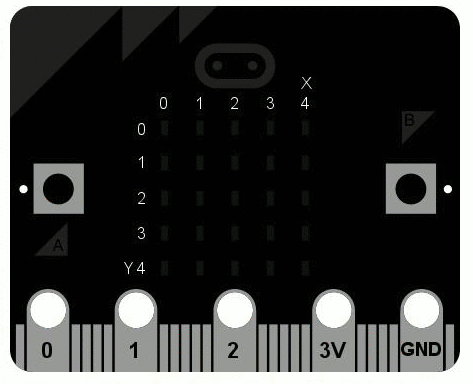Hello, World!
The traditional way to start programming in a new language is to get your computer to say, “Hello, World!”.

This is easy with MicroPython:
from microbit import *
display.scroll("Hello, World!")
Each line does something special. The first line:
from microbit import *
…tells MicroPython to get all the stuff it needs to work with the BBC
micro:bit. All this stuff is in a module called microbit (a module
is a library of pre-existing code). When you import something you’re telling
MicroPython that you want to use it, and * is Python’s way to say
everything. So, from microbit import * means, in English, “I want to be
able to use everything from the microbit code library”.
The second line:
display.scroll("Hello, World!")
…tells MicroPython to use the display to scroll the string of characters
“Hello, World!”. The display part of that line is an object from the
microbit module that represents the device’s physical display (we say
“object” instead of “thingy”, “whatsit” or “doodah”). We can tell the display
to do things with a full-stop . followed by what looks like a command (in
fact it’s something we call a method). In this case we’re using the
scroll method. Since scroll needs to know what characters to scroll
across the physical display we specify them between double quotes (")
within parenthesis (( and )). These are called the arguments. So,
display.scroll("Hello, World!") means, in English, “I want you to use the
display to scroll the text ‘Hello, World!’”. If a method doesn’t need any
arguments we make this clear by using empty parenthesis like this: ().
Copy the “Hello, World!” code into your editor and flash it onto the device. Can you work out how to change the message? Can you make it say hello to you? For example, I might make it say “Hello, Nicholas!”. Here’s a clue, you need to change the scroll method’s argument.
Warning
It may not work. :-)
This is where things get fun and MicroPython tries to be helpful. If it encounters an error it will scroll a helpful message on the micro:bit’s display. If it can, it will tell you the line number for where the error can be found.
Python expects you to type EXACTLY the right thing. So, for instance,
Microbit, microbit and microBit are all different things to
Python. If MicroPython complains about a NameError it’s probably
because you’ve typed something inaccurately. It’s like the difference
between referring to “Nicholas” and “Nicolas”. They’re two different people
but their names look very similar.
If MicroPython complains about a SyntaxError you’ve simply typed code
in a way that MicroPython can’t understand. Check you’re not missing any
special characters like " or :. It’s like putting. a full stop in
the middle of a sentence. It’s hard to understand exactly what you mean.
Your microbit may stop responding: you cannot flash new code to it or enter commands into the REPL. If this happens, try power cycling it. That is, unplug the USB cable (and battery cable if it’s connected), then plug the cable back in again. You may also need to quit and re-start your code editor application.